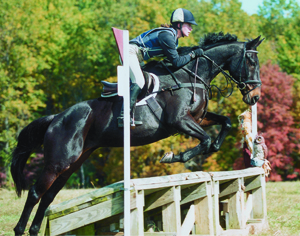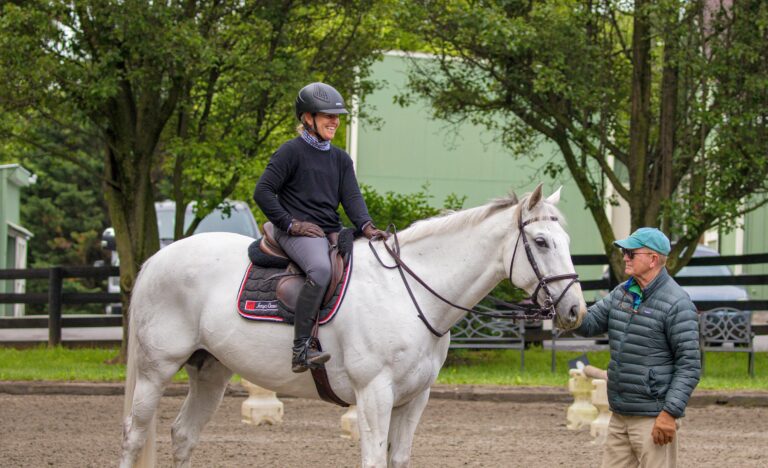Eventing looks like such a fun challenge that you’ve decided to try it. An exciting idea, but where to begin? It all starts with choosing the right eventing horse. If you already own an eventing horse, stay with me; my guidelines will also help you know whether he’s a good fit for the sport.

You may be drawn to eventing at least in part because its upper-level horses are among the world’s most beautiful and accomplished equine athletes. However, remind yourself that the horses who compete at Rolex and Badminton are not the type you should be riding now, even if you can afford one. Your first eventing horse doesn’t need an extended trot that will score a 10 in dressage; he doesn’t need to be able to gallop forever. He needs to be fun to ride and fun to be around, able to carry you safely and comfortably around your first few entry-level events, both in and (especially) out of the ring. Don’t worry about your competitive results at this stage, because your goal is to learn the sport.
It may well be that after 18 months or so you’ll be ready to sell your first horse to another new eventer. You’ll have had such a good experience with this horse that you’ll know what your next event horse needs to be like.
On the ground, your first event horse must be a pleasure to work with. He crossties, stands politely for the vet and farrier, loads easily, and tacks up without problems. Any horse that is unpredictable to work around in his stall, or that kicks or rears, is totally unacceptable for you.
Under saddle, your horse needs to have reasonable aptitude for the three different sports that make eventing such a unique challenge.
Dressage: It all starts with three good gaits.
Walk: I want to see a smooth, free, swinging walk in any horse I’m considering. I don’t want to see a choppy stride or a tendency for the horse to stub his toe or look ungenerous. I want him to track up?that is, his hind foot should step ahead of the footprint of the forefoot on the same side?and I want to hear a steady, rhythmic 1-2-3-4 with no obvious irregularities.
Trot: This gait needs to be a cadenced 1-2, 1-2 that covers the ground comfortably and attractively. When you watch the horse being ridden, his knee action shouldn’t bring a sewing machine to mind. When you ride him, he should be willing to maintain the trot (that is, without breaking back to walk) in response to a minimal amount of pressure from your lower leg and heel.
Canter: You’re looking for a horse with a regular, clocklike three-beat stride?the kind my father used to call a “candy canter.” For your level of eventing, look for a horse who will hold himself in that canter: You should not need a death grip on the reins to prevent his speeding up, and you should not need stick and spurs just to keep him cantering (again, a little lower leg is OK).
In addition to three good gaits, if your horse takes both leads, steers well (turning easily in both directions), accepts the bit well, and maintains a consistent head and neck position with the front of his face just ahead of the vertical, he has the basic ingredients you need for the entry-level dressage tests.
Cross-country: Among the joys of eventing is that one of its phases takes place in the countryside, not in an enclosed ring. This is something new for the many riders who’ve never ridden outside a ring before, so it’s important to begin with a horse that’s safe and sensible in the open. If you’re trying out an event prospect for purchase, be sure to arrange to take him out for a trot and canter along trails through the woods, around open fields, across rolling terrain, and (if possible) through shallow water. He needs to accept these situations as a matter of course. In a perfect world, you will also be able to jump him over a miniature ditch and up and down a little bank?or to ask a more experienced rider to do it for you. My point is that I want the horse to already know how to do these things, so that he can help you learn to do them.
As an athlete, the horse doesn’t need to be able to achieve racehorse fitness; he does need to be able (with proper conditioning) to slow-canter twice the distance he’ll cover cross-country with a short rest in the middle. That means he should eventually be able to slow-canter 1600 meters (about a mile), walk for a few minutes, and then do the same again without being stressed.
Show jumping: At entry level, you’re more interested in riding a safe jumper than a clean jumper, so the elements you’ll look for in jumping form are the things that most affect safety over fences. When you watch him being ridden, notice whether he invariably lifts his knees when he jumps. A horse that jumps with his knees lower than his elbows is not a good prospect because this form is unsafe. Another grave fault: If he jumps with one leg up and one hanging, it’s a sign that he loses his balance off the ground, making him unsafe for anyone to ride over fences.
When you ride him over jumps, you are looking once more for regularity of pace. You want to be able to canter up to a small fence, jump it, and then canter away at the same speed. A horse that consistently falls behind your leg, or one that’s always trying to rush through the bridle, is not what you want.
If you already have a horse with which you’d like to try eventing, and if he has comfortable gaits and is a safe jumper, you’ll probably be able to get started in the sport with him. (His dressage may be a work in progress for a while; but as it improves, you’ll also experience a payback in the other phases.)
If you’re shopping for your first event horse, where should you look? A young racetrack reject is not a suitable candidate; if you’re just learning the sport, don’t take on a green horse as a project. A better prospect is the experienced older eventing horse who’s out of a job because his rider has gone off to college. He’s likely to be offered at a reasonable price because he’s no longer young. His vet bills may be higher, but he has a lot to teach.
I like Quarter Horses for entry-level eventing, and I like older warmbloods who’ve been around the block. Of course, anyone who knows me knows my personal fondness for Thoroughbreds. I don’t steer entry-level riders away from this wonderful breed, but I do suggest you look for a Thoroughbred who no longer wants to be first out of the starting gate.
This article was originally published in the May 2006 issue of Practical Horseman magazine.
Ready to look for the right horse for you? Go to Equine.com, the premier classifieds site of the Equine Network, to search for the perfect horse!










